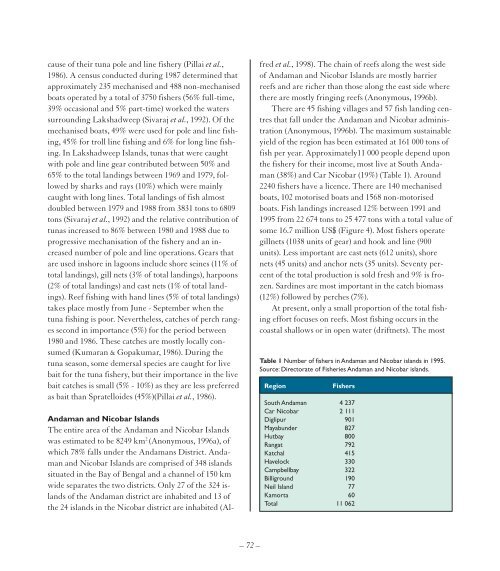Create successful ePaper yourself
Turn your PDF publications into a flip-book with our unique Google optimized e-Paper software.
cause of their tuna pole and line fishery (Pillai et al.,<br />
1986). A census conducted during 1987 determined that<br />
approximately 235 mechanised and 488 non-mechanised<br />
boats operated by a total of 3750 fishers (56% full-time,<br />
39% occasional and 5% part-time) worked the waters<br />
surrounding Lakshadweep (Sivaraj et al., 1992). Of the<br />
mechanised boats, 49% were used for pole and line fishing,<br />
45% for troll line fishing and 6% for long line fishing.<br />
In Lakshadweep Islands, tunas that were caught<br />
with pole and line gear contributed between 50% and<br />
65% to the total landings between 1969 and 1979, followed<br />
by sharks and rays (10%) which were mainly<br />
caught with long lines. Total landings of fish almost<br />
doubled between 1979 and 1988 from 3831 tons to 6809<br />
tons (Sivaraj et al., 1992) and the relative contribution of<br />
tunas increased to 86% between 1980 and 1988 due to<br />
progressive mechanisation of the fishery and an increased<br />
number of pole and line operations. Gears that<br />
are used inshore in lagoons include shore seines (11% of<br />
total landings), gill nets (3% of total landings), harpoons<br />
(2% of total landings) and cast nets (1% of total landings).<br />
Reef fishing with hand lines (5% of total landings)<br />
takes place mostly from June - September when the<br />
tuna fishing is poor. Nevertheless, catches of perch ranges<br />
second in importance (5%) for the period between<br />
1980 and 1986. These catches are mostly locally consumed<br />
(Kumaran & Gopakumar, 1986). During the<br />
tuna season, some demersal species are caught for live<br />
bait for the tuna fishery, but their importance in the live<br />
bait catches is small (5% - 10%) as they are less preferred<br />
as bait than Spratelloides (45%)(Pillai et al., 1986).<br />
Andaman and Nicobar Islands<br />
The entire area of the Andaman and Nicobar Islands<br />
was estimated to be 8249 km 2 (Anonymous, 1996a), of<br />
which 78% falls under the Andamans District. Andaman<br />
and Nicobar Islands are comprised of 348 islands<br />
situated in the Bay of Bengal and a channel of 150 km<br />
wide separates the two districts. Only 27 of the 324 islands<br />
of the Andaman district are inhabited and 13 of<br />
the 24 islands in the Nicobar district are inhabited (Alfred<br />
et al., 1998). The chain of reefs along the west side<br />
of Andaman and Nicobar Islands are mostly barrier<br />
reefs and are richer than those along the east side where<br />
there are mostly fringing reefs (Anonymous, 1996b).<br />
There are 45 fishing villages and 57 fish landing centres<br />
that fall under the Andaman and Nicobar administration<br />
(Anonymous, 1996b). The maximum sustainable<br />
yield of the region has been estimated at 161 000 tons of<br />
fish per year. Approximately11 000 people depend upon<br />
the fishery for their income, most live at South Andaman<br />
(38%) and Car Nicobar (19%) (Table 1). Around<br />
2240 fishers have a licence. There are 140 mechanised<br />
boats, 102 motorised boats and 1568 non-motorised<br />
boats. Fish landings increased 12% between 1991 and<br />
1995 from 22 674 tons to 25 477 tons with a total value of<br />
some 16.7 million US$ (Figure 4). Most fishers operate<br />
gillnets (1038 units of gear) and hook and line (900<br />
units). Less important are cast nets (612 units), shore<br />
nets (45 units) and anchor nets (35 units). Seventy percent<br />
of the total production is sold fresh and 9% is frozen.<br />
Sardines are most important in the catch biomass<br />
(12%) followed by perches (7%).<br />
At present, only a small proportion of the total fishing<br />
effort focuses on reefs. Most fishing occurs in the<br />
coastal shallows or in open water (driftnets). The most<br />
Table 1 Number of fishers in Andaman and Nicobar islands in 1995.<br />
Source: Directorate of Fisheries Andaman and Nicobar islands.<br />
Region<br />
Fishers<br />
South Andaman 4 237<br />
Car Nicobar 2 111<br />
Diglipur 901<br />
Mayabunder 827<br />
Hutbay 800<br />
Rangat 792<br />
Katchal 415<br />
Havelock 330<br />
Campbellbay 322<br />
Billiground 190<br />
Neil Island 77<br />
Kamorta 60<br />
Total 11 062<br />
– 72 –


















